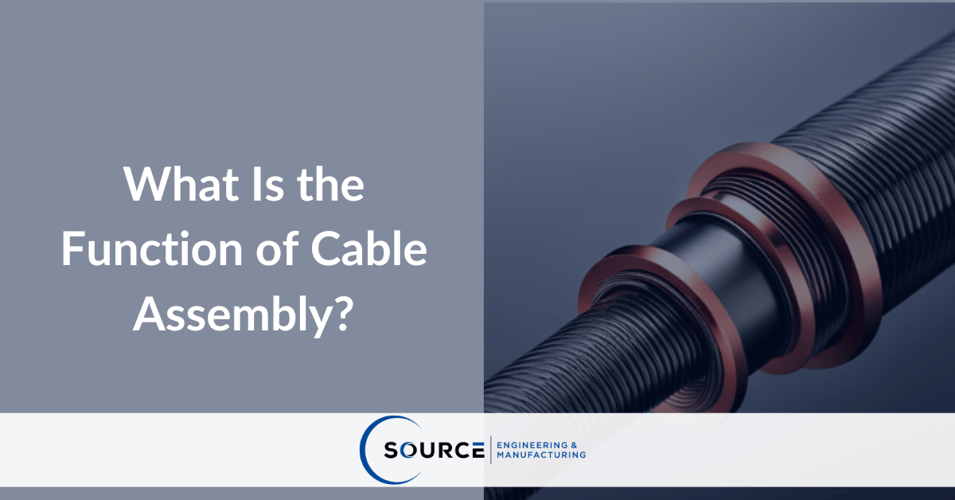
Table of Contents
Cable assemblies are foundational in ensuring efficient and reliable connections in electrical and electronic devices. These components, sometimes confused with their counterpart, the custom cable assembly, are critical in many applications, ranging from simple household electronics to complex industrial machinery. But what exactly is the function of a cable assembly, and why is its role so pivotal in the broader spectrum of technology and industry?
What Is the Function of Cable Assembly?
A cable assembly essentially serves as the bridge for transmitting signals or electrical power between two points. Its core function is to consolidate multiple electrical cables into a single unit to improve organization and reduce the space used by cables. This not only simplifies installation but also enhances the overall system's durability and reduces the risk of errors in connection.
The cable assembly's meaning extends beyond mere organization and space efficiency. It plays a crucial role in protecting the internal wires and cables from external environmental factors such as abrasion, moisture, and chemical vapors, which could potentially damage the conductors and impair the system's functionality.
What Does a Cable Assembly Do?
The Role of a Cable Assembly
The role of a cable assembly is multifaceted. It ensures electronic systems function smoothly by providing a secure and stable path for transmitting power or signals. This stability is particularly crucial in systems where reliability and accuracy are paramount, such as medical equipment, automotive controls, and industrial machinery.
In addition to their primary functions, cable assemblies are custom-designed to meet specific requirements, ensuring compatibility and optimizing application performance. This adaptability is essential in today’s fast-paced and diverse technological landscape, where the demands and environments can vary significantly from one industry to another. It is this bespoke nature that allows cable assemblies to be effectively used in such a wide range of settings, from aerospace to telecommunications, demonstrating their versatility and indispensable nature.
Our commitment to providing reliable, high-quality cable assemblies is evident in the meticulous design and manufacturing process we adhere to. We understand that the effectiveness of your equipment hinges on the quality of its components, which is why we focus on delivering products that meet the highest standards of durability, reliability, and performance. By investing in a professional and customer-focused partner for your cable assembly needs, you ensure the longevity and efficiency of your devices.
Cable assemblies are integral to a multitude of industries, including but not limited to:
- Aerospace and Aviation: For navigational systems, control towers, and cockpit instrumentation.
- Medical Devices: Used in diagnostic equipment, patient monitoring systems, and surgical devices.
- Telecommunications: Essential for data transmission, networking infrastructure, and mobile communications.
- Automotive: In vehicle control systems, infotainment units, and electrical wiring harnesses.
- Industrial Machinery: For power distribution, control systems, and automation processes.
By leveraging cable assemblies' unique properties and customized design, industries can achieve improved performance, enhanced safety, and greater efficiency in their operations. This underscores the invaluable role these components play in modern technology and manufacturing sectors.
Wire Harness vs Cable Assembly
While often used interchangeably, there is a nuanced difference between a wire harness and a cable assembly. A wire harness is a grouping of wires or cables designed to streamline the setup process and mitigate the space occupied. On the other hand, a cable assembly is a more complex structure, offering a higher level of protection by encasing cables and wires within a durable material. This distinction highlights cable assemblies' tailored functionality, especially in environments that demand higher resistance to external stresses.
Conclusion
Cable assemblies are the unsung heroes behind many technological advancements and industrial achievements. They provide not only the means for electrical connectivity but also ensure that this connectivity is reliable, safe, and efficient across various applications. From simple household gadgets to sophisticated aerospace technologies, the functionality of cable assemblies underpins the performance and reliability of devices and systems.
For those seeking further exploration or needing expert consultation on custom cable assemblies, consider visiting sourceeng.com. Their expertise and commitment to quality assure that your needs for reliable cable solutions are met with precision and professionalism.
In conclusion, understanding the function and importance of cable assemblies helps appreciate the complexity and sophistication behind today's technological and industrial marvels. It underscores the necessity of choosing quality assemblies from reputable manufacturers and suppliers to ensure the longevity and reliability of your systems and devices.
FAQ's
What are the key components of a cable assembly?
A cable assembly typically consists of several important components, including:
- Conductors: Wires that carry electrical signals.
- Insulation: Material that prevents short circuits and protects wires.
- Connectors: Devices that join cables to devices or systems.
- Strain relief: Supports to prevent damage at connection points.
How do I choose the right cable assembly for my project?
Selecting the right cable assembly involves considering:
- Application: Determine the specific use case.
- Environment: Assess conditions like temperature and exposure to chemicals.
- Length and gauge: Choose appropriate length and wire thickness for efficiency.
- Connector compatibility: Ensure connectors fit your devices.
What industries commonly use cable assemblies?
Cable assemblies are used across various industries, including:
- Automotive: For electrical systems and controls.
- Aerospace: In avionics and communication systems.
- Telecommunications: For data and signal transmission.
- Medical: In devices and equipment for patient monitoring.
How can I maintain cable assemblies for longevity?
To ensure cable assemblies last longer, follow these tips:
- Regular inspections: Check for wear and tear or damage.
- Proper storage: Keep them in a dry, temperature-controlled environment.
- Avoid tight bends: Prevent stress on cables that can lead to breakage.
- Use protective coverings: Consider using sleeves or conduit for added protection.
What are the benefits of custom cable assemblies?
Custom cable assemblies offer several advantages:
- Tailored design: Fits specific applications and requirements.
- Improved performance: Optimized for unique environments and conditions.
- Cost-effectiveness: Reduces waste and improves efficiency.
- Enhanced reliability: Built to meet exact standards and specifications.
What safety standards should cable assemblies meet?
Cable assemblies should comply with various safety standards, such as:
- UL (Underwriters Laboratories) certification: Ensures safety and reliability.
- RoHS (Restriction of Hazardous Substances): Limits harmful materials.
- ISO (International Organization for Standardization): Ensures quality management.
- NEC (National Electrical Code): Governs safe electrical installations.
What testing methods are used for cable assemblies?
Common testing methods for cable assemblies include:
- Continuity testing: Ensures all connections are intact.
- Insulation resistance testing: Checks for leakage currents.
- Visual inspection: Identifies physical defects or damage.
- Environmental testing: Assesses performance under different conditions.
When should I consider replacing a cable assembly?
You should consider replacing a cable assembly if:
- Visible damage: Frays, cuts, or corrosion are present.
- Performance issues: Frequent connectivity problems or signal loss.
- Age: If the assembly is old and no longer meets safety standards.
- Upgrades: New technology requires more advanced cable specifications.

.png?width=400&name=Source%20Engineering%20Blog%20(1).png)


